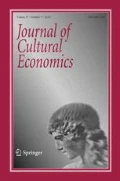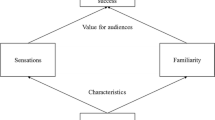Abstract
Everyone knows that the movie business is risky. But how risky is it? Do strategies exist that reduce risk? We investigate these questions using a sample of over 2000 motion pictures. We discover that box-office revenues are asymptotically Pareto-distributed and have infinite variance. The mean is dominated by rare blockbuster movies that are located in the far right tail. There is no typical movie because box-office revenue outcomes do not converge to an average: revenues diverge over all scales. The studio model of risk management lacks a foundation in theory or evidence, and revenue forecasts have zero precision. Movies are complex products and the cascade of information among film-goers during the course of a film's run can evolve along so many paths that it is impossible to attribute the success of a movie to individual causal factors. The audience makes a movie a hit and no amount of “star power” or marketing can alter that. The real star is the movie.
Similar content being viewed by others
References
Albert, S. (1998) “Movie Stars and the Distribution of Financially Successful Films in the Motion Picture Industry”. Journal of Cultural Economics 22(4): 249–270.
Atkinson, A.B. and Harrison, A.J. (1978) Distribution of Personal Wealth in Britain. Cambridge University Press, Cambridge.
Bikhchandani, S., Hirshleifer, D., and Welch, I. (1992) “A Theory of Fads, Fashion, Custom, and Cultural Change as Informational Cascades”. Journal of Political Economy 100(5): 992–1026.
Blumenthal, M.A. (1988) “Auctions with Constrained Information: Blind Bidding for Motion Pictures”. Review of Economics and Statistics 70(2): 191–198.
Chisholm, D.C. (1996) “Continuous Degrees of Residual Claimancy: Some Contractual Evidence”. Applied Economics Letters 3(11): 739–741.
Chisholm, D.C. (1997) “Profit-Sharing Versus Fixed-Payment Contracts: Evidence from the Motion Pictures Industry”. Journal of Law, Economics and Organization 13(1): 169–201.
Chung, K.H. and Cox, R.A.K. (1994) “A Stochastic Model of Superstardom: An Application of the Yule Distribution”. Review of Economics and Statistics 76(4): 771–775.
Cones, J.W. (1997) The Feature Film Distribution Deal. Southern Illinois University Press, Carbondale.
Dale, M. (1997) The Movie Game: The Film Business in Britain, Europe and America. Cassell, London.
De Vany, A.S. (1997) “Complexity in the Movies”, in Complexity: The Journal of the Santa Fe Institute, (forthcoming).
De Vany, A.S. and Eckert, R. (1991) “Motion Picture Antitrust: The Paramount Cases Revisited”. Research in Law and Economics 14: 51–112.
De Vany, A.S. and Walls, W.D. (1996) “Bose–Einstein Dynamics and Adaptive Contracting in the Motion Picture Industry”. The Economic Journal 439(106): 1493–1514.
De Vany, A.S. and Walls, W.D. (1997) “The Market for Motion Pictures: Rank, Revenue and Survival”. Economic Inquiry 4(35): 783–797.
De Vany, A.S. and Walls, W.D. (1999) “Screen Wars, Star Wars, and the Blockbuster Strategy: Turbulent Information Cascades at the Box Office”. Working Paper, University of California at Irvine.
Fama, E. (1963) “Mandelbrot and the Stable Paretian Hypothesis”. Journal of Business 36(4): 420–429.
Goldman, W. (1983) Adventures in the Film Trade. Warner Books, New York.
Hamilton, L.C. (1991) “How Robust is Robust Regression?” Stata Technical Bulletin 2: 21–26.
Hill, B. and Woodrofe, M. (1975) “Stronger Forms of Zipf' Law”. Journal of the American Statistical Association 70(349): 212–219.
Ijiri, Y. and Simon, H.A. (1971) “Effects of Mergers and Acquisitions on Business Firm Concentration”. Journal of Political Economy 79(2): 314–322.
Ijiri, Y. and Simon, H.A. (1977). Skew Distributions and the Size of Business Firms. North-Holland, New York.
Kenney, R.W. and Klein, B. (1983) “The Economics of Block Booking”. Journal of Law and Economics 26: 497–540.
Langer, E.J. (1975) “The Illusion of Control”. Journal of Personality and Social Psychology 32: 311–338.
Lee, C. (1998) “Bose–Einstein Dynamics in the Motion Picture Industry Revisited”. Mimeo, Economics Department, University of California at Irvine.
Levinthal, D.A. and March, J.G. (1993) “The Myopia of Learning”. Strategic Management Journal 14: 95–112.
Levy, M. and Soloman, S. (1998) “Of Wealth Power and Law: The Origin of Scaling in Economics”. Racah Institute of Physics, Hebrew University.
Lukk, T. (1997) Movie Marketing: Opening the Picture and Giving It Legs. Silman-James Press, Los Angeles.
Mandelbrot, B. (1963) “The Variation of Certain Speculative Prices”. Journal of Business 36: 394-419.
Mantegna, R.N. and Stanley, H.E. (1995) “Scaling in Financial Markets”. Nature 376: 46–49.
Pareto, V. (1897) Cours d'Economique Politique.
Prag, J. and Cassavant, J. (1994) “An Empirical Study of Determinants of Revenues and Marketing Expenditures in the Motion Picture Industry” Journal of Cultural Economics 18(3): 217–235.
Presson, P.K. and Benassi, V.A. (1996) “Illusion of Control: A Meta-Analytic Review”. Journal of Social Behavior and Personality 11(3): 493–510.
Ravid, S.A. (1998) “Information, Blockbusters and Stars: A Study of the Film Industry”. Working paper, New York University.
Rosen, S. (1981) “The Economics of Superstars”. American Economic Review 71: 167–183.
Vogel, H.L. (1990) Entertainment Industry Economics: A Guide for Financial Analysis. Cambridge University Press, New York, second edition.
Wallace, W.T., Seigerman, A., and Holbrook, M.B. (1993) “The Role of Actors and Actresses in the Success of Films: How Much is a Movie Star Worth?” Journal of Cultural Economics 17(1): 1–24.
Walls, W.D. (1997) “Increasing Returns to Information: Evidence from the Hong Kong Movie Market”. Applied Economics Letters 4(5): 187–190.
Walls, W.D. (1998) “Product survival at the cinema: Evidence from Hong Kong”. Applied Economics Letters 5(4): 215–219.
Weinstein, M. (1998) “Profit-Sharing Contracts in Hollywood: Evolution and Analysis”. Journal of Legal Studies 27(1): 67–112.
Author information
Authors and Affiliations
Rights and permissions
About this article
Cite this article
De Vany, A., Walls, W.D. Uncertainty in the Movie Industry: Does Star Power Reduce the Terror of the Box Office?. Journal of Cultural Economics 23, 285–318 (1999). https://doi.org/10.1023/A:1007608125988
Issue Date:
DOI: https://doi.org/10.1023/A:1007608125988




